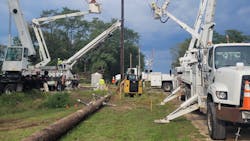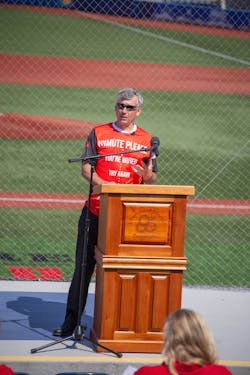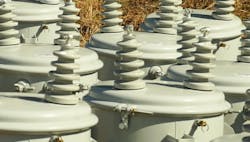Cooperation Among Cooperatives: Rural Utility CEOs Sound off on Their Biggest Challenges
Cooperation over long distances is a defining feature of electric cooperatives, Chris Christiansen, president of NRECA’s board of directors, said in his keynote address.
“I went to college in Boseman, which was a six-hour drive for me for all the five years it took for me to get that degree,” Christiansen said to laughter from the audience. “Now I’m on the road most of the year. Billings is a four-hour drive for us. We have about 3140 meters and less than 2000 customers. We have less than 1 meter per mile. Our service area is bigger than some of our states. Without the co-op business model and co-ops working together, these are people who would not get power.”
Before being elected to his two-year term as board president, Christiansen was a director of NorVal Electric Cooperative in Montana, a seat he still holds on the board of a cooperative with 19 employees, according to its website.
Cooperatives preside over an enormous geographical area – about 56% of the landmass in the U.S. From fast-growing suburbs to rural communities, more than 42 million people depend on co-ops for electricity and other services.
At the same time, co-ops face some of the same issues faced by larger utilities serving more people in a smaller area – namely supply chain disruptions, hiring good people, customer demands for cleaner energy, an inflation-plagued economy and electric vehicle adoption.
Sitting down for an interview with T&D World, Tony Anderson, CEO of Grawn, Michigan’s Cherryland Electric Cooperative, said his co-op’s service territory has grown by about 400 meters. If Michigan’s lower peninsula is a mitten, Cherryland’s service territory is in the small finger.
“When we shut down for Covid, our sales went up. And we thought 2020 was going to be the year for residential. We're 95% residential. We thought that was going to be the high-water mark and we beat that in 2021. And now we started 2022 with even higher sales,” Anderson said. “While I'm an advocate for getting back to the office, I think there's a lot of people staying at home and it's increased our sales and so we're just begging and borrowing that wherever we can scrounge materials.”
Anderson described talking with electricity equipment distributors to get some extra transformers or meter loops during times of constrained availability, which makes planning too far into the future a difficult prospect.
Mike Casper, CEO of Elizabeth, Illinois’ Jo-Carroll Energy, agreed, saying they are working more closely with vendors than they previously had to.
“Now people are moving in. We're trying to serve them better or even constructing new homes. So, pad-mount transformers are a challenge right now – large, long lead times. But we're trying to get creative. We're repurposing stuff as much as we can from a safety standpoint,” Casper said.
Casper’s and Anderson’s co-ops are both primarily residential utilities, so swings in the housing market can have outsized effects as well.
“We ran out of meter loops, so we had to pull all that back in and drive everybody back to our office. And if they didn't need it tomorrow, they didn't get it, you know, whereas we were staging them two and three weeks out before, which involves essentially more communication with the builders in our area. The supplies are short. It's not going to be as convenient for you to get that temporary service.
Applying New Technologies
With the unique spot cooperatives are in, having fewer meters to serve in sometimes more geographically isolated areas, co-ops can sometimes become laboratories for new technological applications.
Scott Peterson, Senior Vice President of Communications for NRECA, said Wake Electric in North Carolina worked with local builders to put in a microgrid with added resilience into new developments. This will help the co-op spend less in on-site generation.
“And to the residents coming into that development you say, hey, we can do this as a service for you and give you everything you need just to make sure that you have that reliability and resiliency that you're looking for,” Peterson said. “Yeah, that's a selling point. A selling point for the utilities and a selling point for the builder.”
Chris Jones, CEO of Middle Tennessee Electric Membership Corporation, which is based in Murfreesboro, said his co-op had finished a few novel projects before the pandemic began and finished during it.
“We put a Tesla battery in one of our substations and we are trying to build a strategy around EVs. And our strategy has really been to try several different things and to see what sticks. We've got fairly high [EV] adoption in our area,” Jones said.
He added that finding the funding to explore new technologies can be daunting for his and other co-ops.
“We want to be on the leading edge. But I'm on the bleeding edge, right? Especially as co-ops and as frugal and focused on our members and what their needs are and trying to understand what member expectations are in this changing environment is a heck of a challenge.”
Decarbonizing Cooperative Power
Anderson said in his area, there is a lot of interest from customers about clean energy, and a handful of environmental groups putting pressure on local utilities, but his attitude is that the energy has to be affordable first. He said Cherryland’s generation and transmission utility, Wolverine Power Supply Cooperative, has negotiated some cleaner energy over the years.
“Twenty years ago, we were less than 5% renewable and over the last 20 years, we're now 62% carbon free. So, they focused on affordability, and they are a smaller [generation and transmission utility], so they've been able to move and negotiate quicker than the IOUs and stuff and take advantage of the tax credits that developers are putting out,” Anderson said. “It's got to be affordable first and then we'll do it.”
Cherryland did the first community solar project in Michigan back in 2013, Anderson said, but the co-op also built a low-income solar project for about 50 homes thanks to some state-level funding as well as some funding from the co-op.
Casper said his cooperative spoke with Cherryland about this project and developed a similar project along the same lines.
“Because of the incentives in Illinois, we were able to develop a similar program, mostly for our members low-income home energy assistance program,” Casper said.
Peterson said NRECA’s federal government lobbying arm has discussed tax incentives and renewable energy with members of Congress.
“One of our legislative priorities is direct payment of tax incentives. As co-ops, we are not able to leverage that. As nonprofits, we aren’t able to leverage traditional tax incentives. We have to have a partner to do that,” Peterson said.
NRECA favors cooperatives receiving direct-pay tax incentives with co-ops either working independently or alongside their generation and transmission utility partners.
“That's a big issue for us going forward with advanced energy options. It can be renewables. It can be other things that can be microgrids. But, you know, there's a lot of innovation is happening at cooperatives because they are nimble. They're able to be able to move pretty quickly,” Peterson said.
Anderson said there will be more innovation from co-ops when favorable legislation is passed.
“Because then our G&T can get involved and creative. Right now, our G&T is dealing with a wind developer here, a solar developer there, and they don't have much opportunity to shape it. They've just got to take the product,” he said.
Anderson said guidance and support from the federal government is more helpful than mandates.
“When you have mandates from the government for renewable or carbon free energy, prices go up. And we saw that in Michigan under Gov. [Jennifer] Granholm, who of course now is secretary of energy. With her we had a renewable mandate that we had to meet, and prices were terrible. As soon as the mandate went away, prices went down, and we took advantage of that,” Anderson said.
Building Rural Areas a Better Grid
Of course, reliably keeping the lights on is job one for every utility, regardless of size. In a time of increasing climate-related, economic and workplace disruptions, an intense focus on the fundamentals sees co-ops through.
“You’ve got to do your meat and potatoes well,” Jones said. “You’ve got to do you equipment maintenance and for us especially right-of-way maintenance. You’ve got to be diligent and consistent and somewhat relentless in that pursuit.”
Attaining the next level of reliable service, however, seems unlikely without developing self-healing grids.
“But when we think about the next level, we think about smart grid. You know, we're thinking about it and we are in the process of building out, developing a true smart grid. And so that's the next step for us,” Jones said. “That's the direction we're going and it's hard to imagine it's going to get much better than what we're doing from a reliability and resiliency standpoint until we finish that part.”
Anderson says more reliable service begins with transmission. Cherryland’s G&T partner has worked to harden its transmission system for outage prevention, he said.
“If you look at their history over the last 20 years they've done a great job of building a better system,” Anderson said. “And then distribution automation is the next level.”
Anderson said getting to a “four nines” level of reliability, meaning 99.99% reliability, is a difficult task.
“We were at 99.98. We wanted to round up, but we didn’t. We talk a lot to our employee group that 99.97 is not acceptable,” Anderson said. “We are working on automated switching now where it all used to be manual where you flip a switch. Now I’ve got an engineer who’s somewhere here at TechAdvantage right now working on the scripts for how that will work. To get to those four nines, you have to do those micro steps and, and that's where distribution automation will get you there.”
Bringing additional reliability to bear for all customers, particularly commercial and industrial customers, is all about transmission, Casper said.
“For us to go out and spend, you know, $100 million, which is a lot of money for a smaller cooperative, let's work with transmission companies in the area that are focused on that. And so that's what we did. We actually sold 25 miles of our sub transmission. They're rebuilding it to full transmission,” Casper said. “So we are intermingled not only with our G&T utility but also with a larger IOU as well. Again, it's multiple feeds coming into small communities that we serve, which is a little unique in the co-op world.”
Biggest Job Since Rural Electrification
Aside from “transmission,” another word spoken often at TechAdvantage was “broadband.” In his keynote speech, Chris Christiansen said he was proud of what NRECA member co-ops have done to bring high-speed internet to areas that would not otherwise have it.
“In the ‘30s and ‘40s, it was almost a miracle what we did to provide electricity to people outside the normal IOU systems. Now people need us to do the same thing with broadband,” Christiansen said. He was not the only person at the conference to compare New Deal Era rural electrification with bringing high-speed internet to rural areas.
“We see a historical parallel relative to this issue. [Rural electrification] is what brought us into existence in the first place. The parallel is there's a segment of the population right now that because of the lack of service, based on where they live, they have less opportunity, they have a lower standard of living than other people do that are typically in the cities,” Jones said. “You know without broadband you're handicapped if you don't have it in that some people have Internet service but not broadband and that's what we're trying to deliver to this area.
Jones said in his state, Tennessee, state lawmakers had to be convinced to allow cooperatives to enter the broadband market.
“In our state, electric cooperatives weren't allowed to operate in the broadband business space. So, we had a job to do to convince the state. And thankfully, we had a very receptive audience because there was a high level of motivation to answer this issue,” Jones said.
Anderson said Cherryland is bringing broadband to customers with a combination of small and large providers.
“What we've done is charter a big cable company. They've got enough money to serve some of our unserved areas. So, we're working with them on getting people the best make-ready price. I think they're going to get to 2000 of those unserved people in the next couple of years,” Anderson said.
For some other customers, a group of smaller providers can make high-speed internet available.
“So, we've got a patchwork of ‘how can I help you’ and ‘how can I help you?’ And I expect in the next five years we're going to accomplish the ultimate goal, which is we all want to get service to everybody,” he said.
About the Author
Jeff Postelwait
Managing Editor
Jeff Postelwait is a writer and editor with a background in newspapers and online editing who has been writing about the electric utility industry since 2008. Jeff is senior editor for T&D World magazine and sits on the advisory board of the T&D World Conference and Exhibition. Utility Products, Power Engineering, Powergrid International and Electric Light & Power are some of the other publications in which Jeff's work has been featured. Jeff received his degree in journalism news editing from Oklahoma State University and currently operates out of Oregon.





